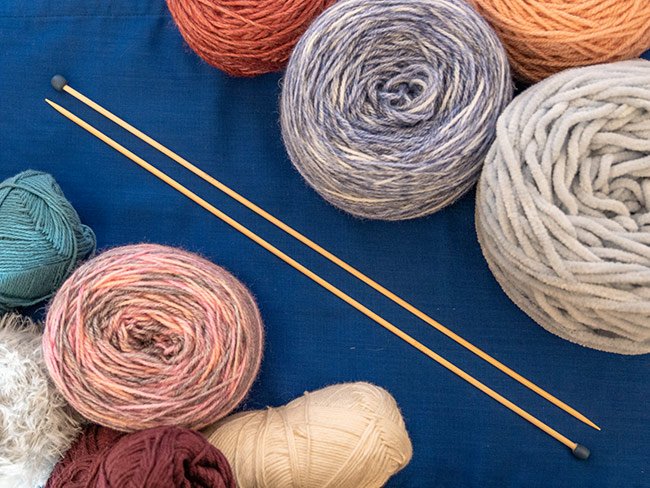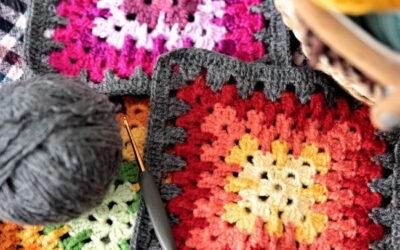Knitting or crocheting: what are the differences?
Not sure whether to take up crochet or knitting? Find your answer here! Whether you’re a beginner or already have some experience, I’ll help you understand the main differences between these two techniques, as well as their advantages and disadvantages. Find out which yarn art best suits your desires and future projects!
The Fundamental Differences Between Knitting and Crocheting
Equipment used
When you start knitting or crocheting, the first big difference is in the materials you use. For knitting, you need two knitting needles. These needles can be straight or circular, and they come in different sizes, lengths and materials such as wood, metal or plastic. Knitting needles are designed to support a row of active stitches, which can make knitting more complex in terms of stitch management.
Unlike crochet, where you only need one tool: a hook. Crochets have a hook-shaped end which is used to pull the yarn and form stitches. Hooks also come in different sizes and materials, and some can be long with a cable for Tunisian crochet, a technique that keeps several stitches active, similar to knitting.

Example of a knitting needle

Example of different kind of crochet Hook
Basic Techniques and Points Used
Basic knitting and crochet techniques also differ. In knitting, you mainly use two stitches: the knit stitch and the purl stitch. These stitches can be combined in various ways to create a variety of patterns and textures. Knitting is done by working rows of stitches, and each row is held on the needles until it’s finished.
Advantages and disadvantages of crocheting
Benefits of Crochet
- Initial ease of learning
Crochet is often considered easier for beginners to learn. With only one active stitch to manage at a time, there’s less risk of losing stitches by accident, which can be a frustrating problem for knitting beginners. What’s more, the simple, repetitive nature of basic stitches like chain stitch and tight stitch makes crochet more accessible to those just starting out. - Speed of execution
Crochet can generally be completed faster than knitting. Because crochet stitches are often larger and more widely spaced, they cover more surface area with each stitch. This means that crochet projects progress faster, which is ideal if you want to see results quickly. - Versatile shapes and textures
Crochet is particularly effective at creating three-dimensional shapes and varied textures. This makes it perfect for projects like amigurumis, baskets, and interior decorations. The ability to easily add volume and work in the round gives crochet an advantage for these types of creations. - Easy to correct mistakes
Correcting mistakes is generally easier when crocheting. If you make a mistake, it’s often just a matter of pulling on the yarn to unravel the stitches to the point where you want to correct. Since there’s only one active stitch, you can easily pick up where you left off without the risk of losing any more stitches.

Mushroom Keychain Pattern by Yarn & Crochet
Disadvantages of Crochet
- Yarn consumption
One of the main drawbacks of crochet is that it generally uses more yarn than knitting. Crochet stitches are bulkier and denser, requiring more material to cover the same surface area. This can increase the cost of projects, especially large-scale ones such as blankets. - Fabric rendering
Crocheted fabric is often stiffer and less stretchy than knitted fabric. This can limit the use of crochet for certain types of garment, especially those requiring a flowing, delicate drape, such as lightweight sweaters or shawls. Crochet garments tend to be more structured and less fitted. - Pattern complexity for beginners
While basic stitches are easy to learn, some advanced crochet stitches and techniques can be more difficult to master. Complex patterns, especially those involving frequent color changes or highly detailed textures, can be intimidating for beginners. - Difficulty managing yarn tension
In both crochet and knitting, getting fabric with even tension can be a challenge, especially for beginners. Stitches can easily become too loose or too tight, affecting the appearance and final size of the project. Regular practice is essential to master tension and produce consistent work.
Advantages and disadvantages of knitting
Advantages of knitting
- Variety of textures and patterns
Knitting offers a wide variety of textures and patterns. With just two basic stitches, purl and knit, it’s possible to create a multitude of patterns by playing with their combination. Techniques such as twists, jacquards and openwork stitches add even more diversity and complexity to projects. - Draping and elasticity
Knitted fabric is often softer and more stretchy than crocheted fabric. This quality makes it the ideal choice for snug, comfortable garments such as sweaters, socks and hats. The natural drape of knit fabric makes it possible to create pieces that hug the body better and are more comfortable to wear. - Yarn savings
Knitting generally uses less yarn than crochet to cover the same surface area. This can make knitting projects more economical, especially when using high-quality or expensive yarns. This material saving is a significant advantage for large projects such as blankets or bulky garments. - Seamless projects
Thanks to circular needles and round-knitting techniques, it’s possible to create seamless projects. This method is particularly popular for garments, as it enables one-piece pieces to be made without having to join separate pieces, resulting in a cleaner, more professional finish.

Example of a texture created with Tricot
Disadvantages of knitting
- More complex learning for beginners
Knitting can be more difficult to learn for beginners. Managing several active stitches on the needles can be confusing and frustrating, especially when the stitches slip off the needles. The coordination needed to maintain even tension and handle two needles simultaneously requires more practice. - Correcting mistakes
Correcting mistakes in knitting is often more complicated than in crochet. When a mistake is made, it can be difficult to undo the stitches to the point of error without losing stitches or destabilizing the fabric structure. Repairing mistakes often requires additional skills and a good dose of patience. - Execution time
Knitting can be slower than crochet, especially for beginners. Knitting stitches are generally smaller and tighter, which means it takes longer to cover the same area as crochet. For urgent projects or for those looking for quick results, this slowness can be a disadvantage. - Uniform tension difficult to master
Achieving even tension in both knitting and crochet can be difficult, especially for beginners. Uneven tension can affect the appearance and final size of the project, and correcting tension problems once they’ve appeared can be a challenge. Constant practice and experience are needed to master tension and produce consistent work.
Knitting and Crochet: Similarities and Complementarity
Knitting and crochet, although distinct in their execution and the tools used, share many similarities that make them complementary. These two woolworking techniques offer a multitude of creative possibilities, and many wool art enthusiasts choose to master both to enjoy the unique benefits of each. Here’s a look at what they have in common and how they can complement each other.
Similarities between knitting and crocheting
- Using wool and yarn
Both techniques use yarns of wool, cotton or other materials to create a variety of fabrics and objects. Whether you’re knitting or crocheting, you’ll have access to a wide range of yarns in terms of textures, colors and thicknesses, enabling you to create a wide variety of projects. - Shared skills and techniques
To succeed in any of these areas, you need to develop good hand-eye coordination, attention to detail and an understanding of color and design. The ability to plan and visualize a project from start to finish is crucial, as is the patience to see sometimes lengthy and complex creations through to completion. - Health benefits
Both activities are recognized for their beneficial effects on mental and physical health. They are relaxing, reduce stress, improve concentration and coordination, and offer great personal satisfaction when you finish a project.
Knitting and Crochet complement each other
- Variety of projects:
Some creations are better suited to one technique or the other, but mastering both allows you to expand your range of projects. For example, you could knit a sweater for its smooth, stretchy texture, then add crochet trims or embellishments for a unique detail. Combination projects, such as sweaters with crochet patterns or blankets with knitted and crocheted sections, exploit the best of both worlds. - Learning and adapting
Starting with one technique can make learning the other easier. If you start with crochet, you’ll develop manual dexterity that will come in handy when you learn to knit, and vice versa. What’s more, some knitting techniques, such as temporary piecing, use crochet bases, demonstrating once again how these two arts can complement each other.
Ultimately, knitting and crochet are not rival activities, but rather complementary skills that enrich the creative experience with wool. By mastering both, you’ll increase your flexibility and ability to complete a wider range of projects, while enjoying the unique benefits that each technique brings. Whether you prefer the smooth, stretchy textures of knitting or the structural possibilities of crochet, or choose to combine the two, you’ll find these arts an inexhaustible source of creativity and pleasure.

Little monkey with his crocheted hoodie (amigurumi) / Made by Yarn & Crochet, pattern by sweetpeaplush
To summarize:

Whether you choose knitting or crochet, the important thing is to enjoy yourself and let your creativity run free. Both techniques have their own particularities and charms, and each can bring a great deal of satisfaction. Ultimately, the choice between knitting and crochet will depend on your personal preferences, the nature of the projects you wish to complete and the way you want to express your creativity. Don’t hesitate to try both to discover which technique suits you best!
Discover our other Crochet articles:
How to Read a Crochet Pattern: A Beginner’s Guide
Learning to crochet starts with understanding how to read a pattern. Discover how to decode common abbreviations, choose the right materials, and follow a project from start to finish.
Granny Squares in Crochet: the beginner’s guide
Learn to crochet granny squares easily: origins, magic circle tutorial, diagram reading and lots of creative project ideas.
10 Easy Crochet Accessory Ideas for Beginners
Looking for inspiration for your next crochet project? In this article, you’ll discover 10 trendy accessories that are easy to make, even if you’re just starting out. From colourful scrunchies to rucksacks, get all the creative ideas you need to express your talent while having fun.

by Katy
Creator of Yarn & Crochet



